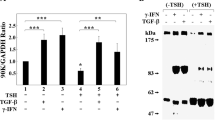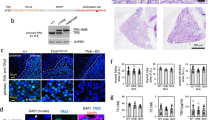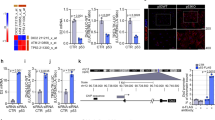Abstract
Thyroid hormone receptors (TRs) are members of the ligand-inducible transcription factor superfamily. The two major functional TRs (α1 and β1) have different spatial and temporal expression patterns and specific physiological functions for these isoforms are now starting to emerge. By expressing these TR isoforms individually in Swiss 3T3 fibroblasts, we found that TRβ1 expression, in the absence of hormone, provokes a proliferation arrest in G0/G1, lengthening the cycling time. Upon serum stimulation TRβ1-expressing cells showed a marked delay in the induction of cyclins D and E, in the phosphorylation of retinoblastoma protein, and in the activation of cyclin-dependent kinase 2, accompanied by increased levels of cyclin-dependent kinase inhibitor p27Kip1. Accordingly, serum-stimulated E2F-1 transcriptional activity was repressed by TRβ1 in transient transfection experiments. Analysis of the receptor domains required for this effect confirmed that there is no need for a functional ligand-binding domain while the DNA-binding domain is essential. In this work, we demonstrate for the first time that TRβ1 participates in the molecular mechanisms that control cell proliferation. The unliganded TRβ1 impairs the normal induction of the G1/S cycle regulators preventing progression into the S phase.
This is a preview of subscription content, access via your institution
Access options
Subscribe to this journal
Receive 50 print issues and online access
$259.00 per year
only $5.18 per issue
Buy this article
- Purchase on Springer Link
- Instant access to full article PDF
Prices may be subject to local taxes which are calculated during checkout








Similar content being viewed by others
Abbreviations
- T3:
-
triiodothyronine
- T4:
-
tetraiodothyronine
- TR:
-
thyroid hormone nuclear receptor
- TRα1:
-
thyroid hormone receptor-α1
- TRβ1:
-
thyroid hormone receptor-β1
- Cdk:
-
cyclin-dependent kinase
- Cki:
-
cyclin-dependent kinase inhibitor
- Rb:
-
retinoblastoma susceptibility protein
- BrdU:
-
5-bromo-2′-deoxyuridine
References
Barrera-Hernandez G, Zhan Q, Wong R and Cheng SY . (1998). DNA Cell Biol., 17, 743–750.
Bauer A, Mikulits W, Lagger G, Stengl G, Brosch G and Beug H . (1998). EMBO J., 17, 4291–4303.
Baumann CT, Maruvada P, Hager GL and Yen PM . (2001). J. Biol. Chem., 276, 11237–11245.
Billon N, Tokumoto Y, Forrest D and Raff M . (2001). Dev. Biol., 235, 110–120.
Brown DD, Wang Z, Kanamori A, Eliceiri B, Furlow JD and Schwartzman R . (1995). Recent. Prog. Horm. Res., 50, 309–315.
Campanero MR, Armstrong MI and Flemington EK . (2000). Proc. Natl. Acad. Sci. USA, 97, 6481–6486.
Carre JL, Demerens C, Rodriguez-Pena A, Floch HH, Vincendon G and Sarlieve LL . (1998). J. Neurosci. Res., 54, 584–594.
Chassande O, Fraichard A, Gauthier K, Flamant F, Legrand C, Savatier P, Laudet V and Samarut J . (1997). Mol. Endocrinol., 11, 1278–1290.
Chomczynski P and Sacchi N . (1987). Anal. Biochem., 162, 156–159.
Durand B and Raff M . (2000). BioEssays, 22, 64–71.
Durand B, Gao FB and Raff M . (1997). EMBO J., 16, 306–317.
Flamant F and Samarut J . (2003). Trends Endocrinol. Metab., 14, 85–90.
Forrest D, Sjoberg M and Vennstrom B . (1990). EMBO J., 9, 1519–1528.
Gonzalez-Sancho JM, Garcia V, Bonilla F and Munoz A . (2003). Cancer Lett., 192, 121–132.
Hashimoto K, Curty FH, Borges PP, Lee CE, Abel ED, Elmquist JK, Cohen RN and Wondisford FE . (2001). Proc. Natl. Acad. Sci. USA, 98, 3998–4003.
Hayashi Y, Sunthornthepvarakul T and Refetoff S . (1994). J. Clin. Invest., 94, 607–615.
Herwig S and Strauss M . (1997). Eur. J. Biochem., 246, 581–601; J. Biol. Chem., 275, 1787, 2000.
Koenig RJ, Lazar MA, Hodin RA, Brent GA, Larsen PR, Chin WW and Moore DD . (1989). Nature, 337, 659–661.
Lebel JM, Dussault JH and Puymirat J . (1994). Proc. Natl. Acad. Sci. USA, 91, 2644–2648.
Markowitz S, Haut M, Stellato T, Gerbic C and Molkentin K . (1989). J. Clin. Invest., 84, 1683–1687.
Morgenstern JP and Land H . (1990). Nucleic Acids Res., 18, 3587–3596.
Nygard M, Wahlstrom GM, Gustafsson MV, Tokumoto YM and Bondesson M . (2003). Mol. Endocrinol., 17, 79–92.
Oberste-Berghaus C, Zanger K, Hashimoto K, Cohen RN, Hollenberg AN and Wondisford FE . (2000). J. Biol. Chem., 275, 1787–1792.
Oppenheimer JH and Schwartz HL . (1997). Endocr. Rev., 18, 462–475.
O’Shea PJ and Williams GR . (2002). J. Endocrinol., 175, 553–570.
Paavonen T . (1982). Scand J. Immunol., 15, 211–215.
Pastor R, Bernal J and Rodriguez-Pena A . (1994). Oncogene, 9, 1081–1089.
Perez-Juste G and Aranda A . (1999). J. Biol. Chem., 274, 5026–5031.
Qi JS, Desai-Yajnik V, Yuan Y and Samuels HH . (1997). Mol. Cell. Biol., 17, 7195–7207.
Rodriguez ER, Tan CD, Onwuta US, Yu ZX, Ferrans VJ and Parrillo JE . (1994). Biochem Biophys Res. Commun., 205, 652–658.
Rozengurt E and Sinnett-Smith J . (1983). Proc. Natl. Acad. Sci. USA, 80, 2936–2940.
Samuels HH, Stanley F and Casanova J . (1979). Endocrinology, 105, 80–85.
Sherr CJ, Kato J, Quelle DE, Matsuoka M and Roussel MF . (1994). Cold Spring Harb. Symp. Quant. Biol., 59, 11–19.
Strait KA, Schwartz HL, Perez-Castillo A and Oppenheimer JH . (1990). J. Biol. Chem., 265, 10514–10521.
Suzuki H, Willingham MC and Cheng SY . (2002). Thyroid, 12, 963–969.
Tokumoto YM, Apperly JA, Gao FB and Raff MC . (2002). Dev. Biol., 245, 224–234.
Yap N, Yu CL and Cheng SY . (1996). Proc. Natl. Acad. Sci. USA, 93, 4273–4277.
Yen PM . (2003). Trends Endocrinol. Metab., 14, 327–333.
Yen PM, Wilcox EC, Hayashi Y, Refetoff S and Chin WW . (1995). Endocrinology, 136, 2845–2851.
Acknowledgements
We thank Dr LL Sarliève for the kind gift of the antibodies against the TRs, Dr MR Campanero for E2F reporter plasmids, and Dr P Maruvada for the TRβ1 mutants. We are especially grateful to Dr Simon Bartlett for critically reading the manuscript and for his valuable comments, and to all members of the laboratory for helpful discussions. This work was supported by grants to AR-P from Dirección General de Investigación Científica y Técnica (M.C.Y.T: SAF2001-1624). SV was supported by a fellowship from Comunidad Autónoma de Madrid. EP is recipient of a predoctoral fellowship from Ministerio de Ciencia y Tecnología associated to the M.C.Y.T. grant.
Author information
Authors and Affiliations
Corresponding author
Additional information
Supplementary Information accompanies the paper on Oncogene website (http://www.nature.com/onc)
Supplementary information
Rights and permissions
About this article
Cite this article
Porlan, E., Vega, S., Iglesias, T. et al. Unliganded thyroid hormone receptor β1 inhibits proliferation of murine fibroblasts by delaying the onset of the G1 cell-cycle signals. Oncogene 23, 8756–8765 (2004). https://doi.org/10.1038/sj.onc.1208126
Received:
Revised:
Accepted:
Published:
Issue Date:
DOI: https://doi.org/10.1038/sj.onc.1208126



